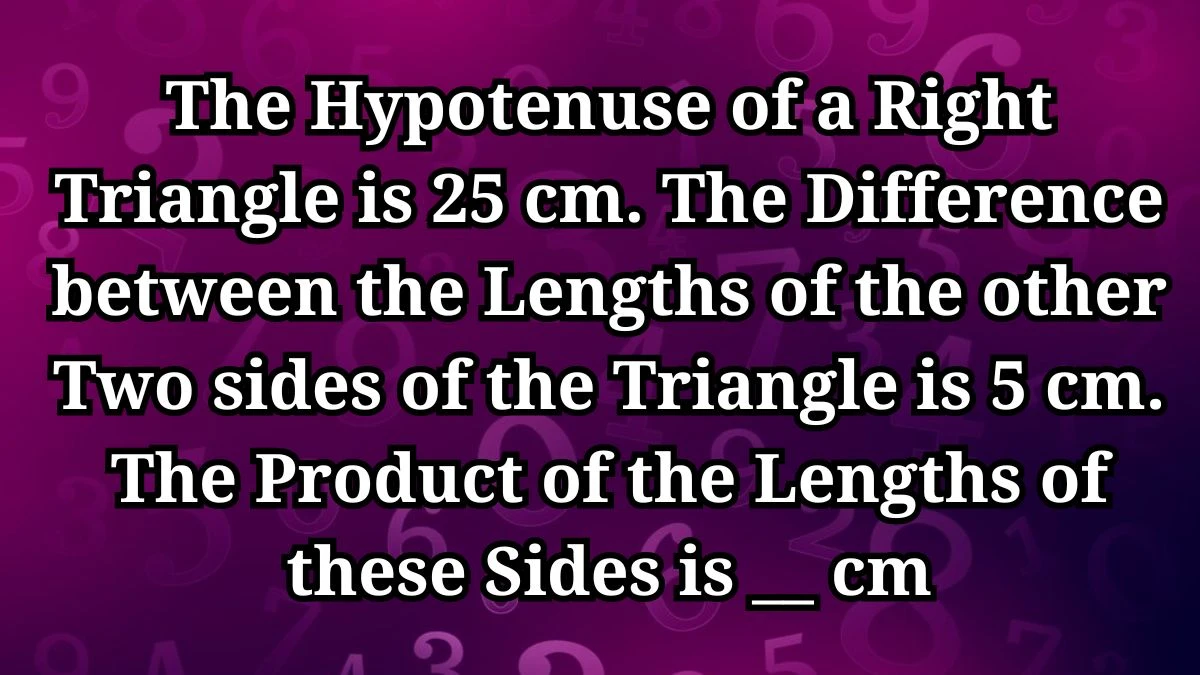The Hypotenuse of a Right Triangle is 25 cm. The Difference between the Lengths of the other Two sides of the Triangle is 5 cm. The Product of the Lengths of these Sides is __ cm
by
Updated Jun 07, 2024

The Hypotenuse of a Right Triangle is 25 cm. The Difference between the Lengths of the other Two sides of the Triangle is 5 cm. The Product of the Lengths of these Sides is __ cm
To solve the problem of finding the product of the lengths of the two sides of a right triangle where the hypotenuse is 25 cm and the difference between the lengths of the other two sides is 5 cm, follow these steps.
First, we define the sides of the triangle. Let one of the sides be x cm. Consequently, the other side, being 5 cm longer, is x+5 cm.
With these definitions, we can use the Pythagorean theorem to relate the sides of the triangle. According to the Pythagorean theorem, the square of the hypotenuse (the longest side of a right triangle) is equal to the sum of the squares of the other two sides. Thus, we set up the equation:
25² = x² + (x+5)²
Next, we simplify and solve the equation. Squaring both sides, we get:
625 = x²+(x²+10x+25)
Combining like terms, this simplifies to:
We then move all terms to one side of the equation to set it to zero:
2x²+10x−600=0
Dividing through by 2 simplifies it further:
x²+5x−300=0
Now, we factorize this quadratic equation. We look for two numbers that multiply to -300 and add up to 5. These numbers are 20 and -15, giving us:
(x+20)(x−15)=0
Solving for x, we find:
x+20=0 or x−15=0
This yields:
x = −20 or x = 15
Since a side length cannot be negative, we discard x = −20 and keep x = 15.
Thus, the sides of the triangle are 15 cm and 20 cm (since x+5=15+5=20).
Finally, to find the product of the lengths of these two sides, we multiply:
15cm×20cm=300cm²
Therefore, the product of the lengths of the two sides of the triangle is 300cm²
Applications of Pythagorean theorem
In mathematics, the hypotenuse of a right triangle is the longest side, opposite the right angle. For a right triangle with a hypotenuse of 25 cm and a difference of 5 cm between the other two sides, we can find the lengths of these sides using the Pythagorean theorem.
The theorem states that the square of the hypotenuse equals the sum of the squares of the other two sides. By setting up and solving the equation, we determine the sides are 15 cm and 20 cm. Multiplying these gives the product of their lengths as 300 square centimeters.
The Pythagorean theorem is a fundamental concept in mathematics that relates the lengths of the sides of a right triangle. It states that in a right triangle, the square of the length of the hypotenuse (the side opposite the right angle) is equal to the sum of the squares of the lengths of the other two sides. This theorem is expressed mathematically as:
c²=a²+b²
Where:
c is the length of the hypotenuse,
a and b are the lengths of the other two sides.
This type of problem highlights the importance of the Pythagorean theorem in mathematics, which is essential in various fields such as geometry, trigonometry, and physics. It helps in calculating distances, designing structures, and solving real-world problems involving right triangles.




